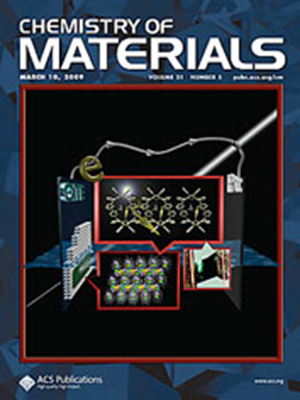Steric Hindrance and Film Quality in HfO2 Atomic Layer Deposition: Comparative Kinetic Monte Carlo Simulation of TEMA-Hf and HfCp(NMe2)3 Precursors
IF 7.2
2区 材料科学
Q2 CHEMISTRY, PHYSICAL
引用次数: 0
Abstract
Hafnia (HfO2)-based ferroelectrics have attracted considerable attention for next-generation memory devices due to their robust ferroelectricity at ultrathin scales. Achieving desired ferroelectric properties relies on the precise control of film quality, which is strongly influenced by deposition conditions, precursor chemistry, and the presence of impurities. Here, we combine density functional theory and kinetic Monte Carlo simulations to investigate the atomic layer deposition of HfO2 films from TEMA–Hf and HfCp(NMe2)3 precursors using O3 as the oxidant. Our results show that both precursors decompose preferentially at 2-coordinate O sites on the HfO2 surface, while 3-coordinate O sites present much higher energy barriers. Kinetic Monte Carlo simulations reveal that growth rates per cycle (GPC) of TEMA-Hf and HfCp(NMe2)3 with O3 are 0.094–0.109 nm/cycle and 0.081–0.096 nm/cycle from 150 to 350 °C, aligning closely with experiments. The slower GPC observed for HfCp(NMe2)3 is attributed to the greater steric hindrance of the cyclopentadienyl ligand (Cp) compared to the dimethylamide(NMe2) groups. Film morphology analysis suggests TEMA-Hf leads to smoother HfO2 films. Nitrogen incorporation remains at about 1% for TEMA–Hf and HfCp(NMe2)3, consistent with experimental observations, while the concentration of O vacancies slightly decreases with the increase of deposition temperature. These findings provide insights into how precursor selection and atomic-level reaction pathways influence film growth and composition, thereby affecting the ferroelectric performance in HfO2-based devices.

HfO2原子层沉积中的位阻和膜质量:TEMA-Hf和HfCp(NMe2)3前驱体的比较动力学蒙特卡罗模拟
基于铪(HfO2)的铁电体由于其在超薄尺度上的强大铁电性而引起了下一代存储器件的广泛关注。实现理想的铁电性能依赖于对薄膜质量的精确控制,而薄膜质量受到沉积条件、前驱体化学和杂质存在的强烈影响。本文将密度泛函理论与动力学蒙特卡罗模拟相结合,研究了以O3为氧化剂,由TEMA-Hf和HfCp(NMe2)3前驱体制备HfO2薄膜的原子层沉积过程。结果表明,这两种前驱体都优先在HfO2表面的二坐标O位分解,而三坐标O位具有更高的能垒。动力学蒙特卡罗模拟表明,在150 ~ 350℃范围内,含O3的TEMA-Hf和HfCp(NMe2)3的每周期生长速率(GPC)分别为0.094 ~ 0.109 nm/周期和0.081 ~ 0.096 nm/周期,与实验结果一致。HfCp(NMe2)3较慢的GPC是由于与二甲酰胺(NMe2)基团相比,环戊二烯基配体(Cp)的空间位阻更大。膜形态分析表明,TEMA-Hf使HfO2膜更光滑。TEMA-Hf和HfCp(NMe2)3的含氮量保持在1%左右,与实验观察结果一致,而O空位浓度随着沉积温度的升高略有下降。这些发现为前驱体选择和原子级反应途径如何影响薄膜的生长和组成,从而影响hfo2基器件的铁电性能提供了见解。
本文章由计算机程序翻译,如有差异,请以英文原文为准。
求助全文
约1分钟内获得全文
求助全文
来源期刊

Chemistry of Materials
工程技术-材料科学:综合
CiteScore
14.10
自引率
5.80%
发文量
929
审稿时长
1.5 months
期刊介绍:
The journal Chemistry of Materials focuses on publishing original research at the intersection of materials science and chemistry. The studies published in the journal involve chemistry as a prominent component and explore topics such as the design, synthesis, characterization, processing, understanding, and application of functional or potentially functional materials. The journal covers various areas of interest, including inorganic and organic solid-state chemistry, nanomaterials, biomaterials, thin films and polymers, and composite/hybrid materials. The journal particularly seeks papers that highlight the creation or development of innovative materials with novel optical, electrical, magnetic, catalytic, or mechanical properties. It is essential that manuscripts on these topics have a primary focus on the chemistry of materials and represent a significant advancement compared to prior research. Before external reviews are sought, submitted manuscripts undergo a review process by a minimum of two editors to ensure their appropriateness for the journal and the presence of sufficient evidence of a significant advance that will be of broad interest to the materials chemistry community.
 求助内容:
求助内容: 应助结果提醒方式:
应助结果提醒方式:


